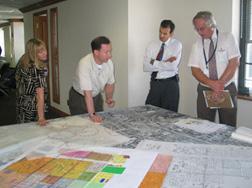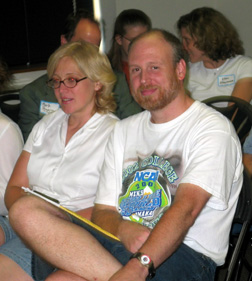 |
Doug Bisson, second from left, project manager of Destination Midtown, explains some of the design team’s ideas to area residents on Tuesday. |
“I’m excited and apprehensive,” said Frey, president of the Gifford Park Neighborhood Association and a midtown resident for the past eight years. “We’re excited that attention is being given to our part of town. This has been a great collaboration between the business community and the neighborhood community.
“But I also know that they’re working on ideas, and it’s part of a long process. That’s the hardest part for people in our neighborhood to understand.”
Frey was among 100 people who attended Thursday’s final presentation, which capped the four-day Destination Midtown design workshop. The next workshop, also called a charrette, will take place in late September or early October and will consist of neighborhood symposiums at which topics such as code enforcement, crime, residential rehabilitation and neighborhood center design will be discussed.
Thursday’s presentation by James Moore, Ph.D., community design principal for HDR, involved midtown roads and their current usage. Dodge and Leavenworth streets are the most important roads to the midtown area, Dr. Moore said. He also proposed that Harney and Farnam streets return to two-way traffic.
 |
Ron Frey, right, president of the Gifford Park Neighborhood Association, attended Thursday night’s presentation with his wife, Vicki. |
“The biggest liabilities are, in fact, the Dodge and Leavenworth corridors and Saddle Creek to some extent,” Dr. Moore said. “Priority has been given to moving cars through the area as opposed to controlling them and helping to strengthen the area.
“We believe that the opportunities are to get a handle on what’s happening on Dodge and Leavenworth, and then return Farnam and Harney to their original two-way condition, thereby making them slightly more friendly or neighborhood-oriented.”
Dr. Moore said there are 15,000 people per day on the grounds of UNMC and The Nebraska Medical Center, plus another 6,000 at Mutual of Omaha.
“That’s a staggering amount of people,” Dr. Moore said. “But they’re clearly not spending much time in the surrounding areas. I know that university facilities tend to have internalized cafeterias and people only have a 30-minute break, but nonetheless, there’s an opportunity there that’s not being met.”
Although Frey said he’s concerned about the fact that most of the funding for Destination Midtown projects will be provided by large businesses, he also thinks this process will help residents and businesses improve their relationship with each other.
“This process has helped people in our neighborhood and the businesses in the area to understand the relationship that we have with each other,” Frey said. “The businesses realize we provide a certain level of potential benefit to them, just as they provide benefits to us in terms of job potential and also the ability to do things that we might not be able to do ourselves.
“But, at the same time, hopefully that’s on a collaborative basis rather than businesses coming in and saying, ‘Well, this is what we’re going to do.'”
Tim and Magan Smith, who have lived in the neighborhood near St. Cecilia Cathedral for five years, are happy to have UNMC and The Nebraska Medical Center as a part of the midtown community.
“We feel very fortunate that UNMC and The Nebraska Medical Center are in the middle of midtown,” she said. “I can’t imagine what it would be like if we didn’t have institutions like that supporting the area. I think it’s crucial to the redevelopment.”
|
|
Tim Smith, who grew up in the midtown area, said he thinks places like UNMC can take a leadership role in the process.
“The difficult thing will be to take the first steps, to be pioneers in the area’s development,” he said. “But I think the medical center and other businesses like Mutual of Omaha have the financial wherewithal and an investment in the neighborhood to take some of those first steps, which I think will then plant a seed for the private sector to follow.”
Dr. Moore said that creating a positive relationship between UNMC and the surrounding neighborhoods is a concern of UNMC Chancellor Harold M. Maurer, M.D.
“Dr. Maurer has to recruit people to come here, and improving midtown Omaha will make it much easier to attract top individuals to UNMC. One of the wonderful, charming things about some schools is that they’re surrounded by a university district that is aesthetically pleasing — nicely landscaped, with a variety of places to go and faculty living a few blocks away. That’s sort of the classic tradition and there’s no reason why it can’t happen here.”
Jim Ducey, who grew up in Dundee and returned to the area a few years ago after living in west Omaha, is excited about the Destination Midtown project.
“They’re coming up with some really good ideas that will make midtown Omaha really vibrant and appealing to the people who live and work in the area,” he said. “I think many of the concerns that I have personally are being worked out through the planning process.”
Ducey has a particular interest in birds and has been impressed with the fact that, during the first few months of the project, a habitat restoration area has already been established in Hanscom Park.
“By in large, the vast majority of the 3.6-square-mile area is in pretty good shape. It contains beautiful, beautiful neighborhoods and gorgeous architecture,” Dr. Moore said. “But there are far too many surface parking lots. We’re trained to look at them and think, ‘What can that be when it grows up?’ Eventually, it makes more sense to build something that will generate some revenue and bring more people to the area.”
Dr. Moore said the medical center has one of the nicest power plants he’s ever seen.
“Somebody put some thought into that facility and designed it so that it makes a very nice neighbor. The ultimate goal is to continue to think along those lines and create a seamless transition from the large medical facilities west of 42nd Street to the residential properties east of there.”